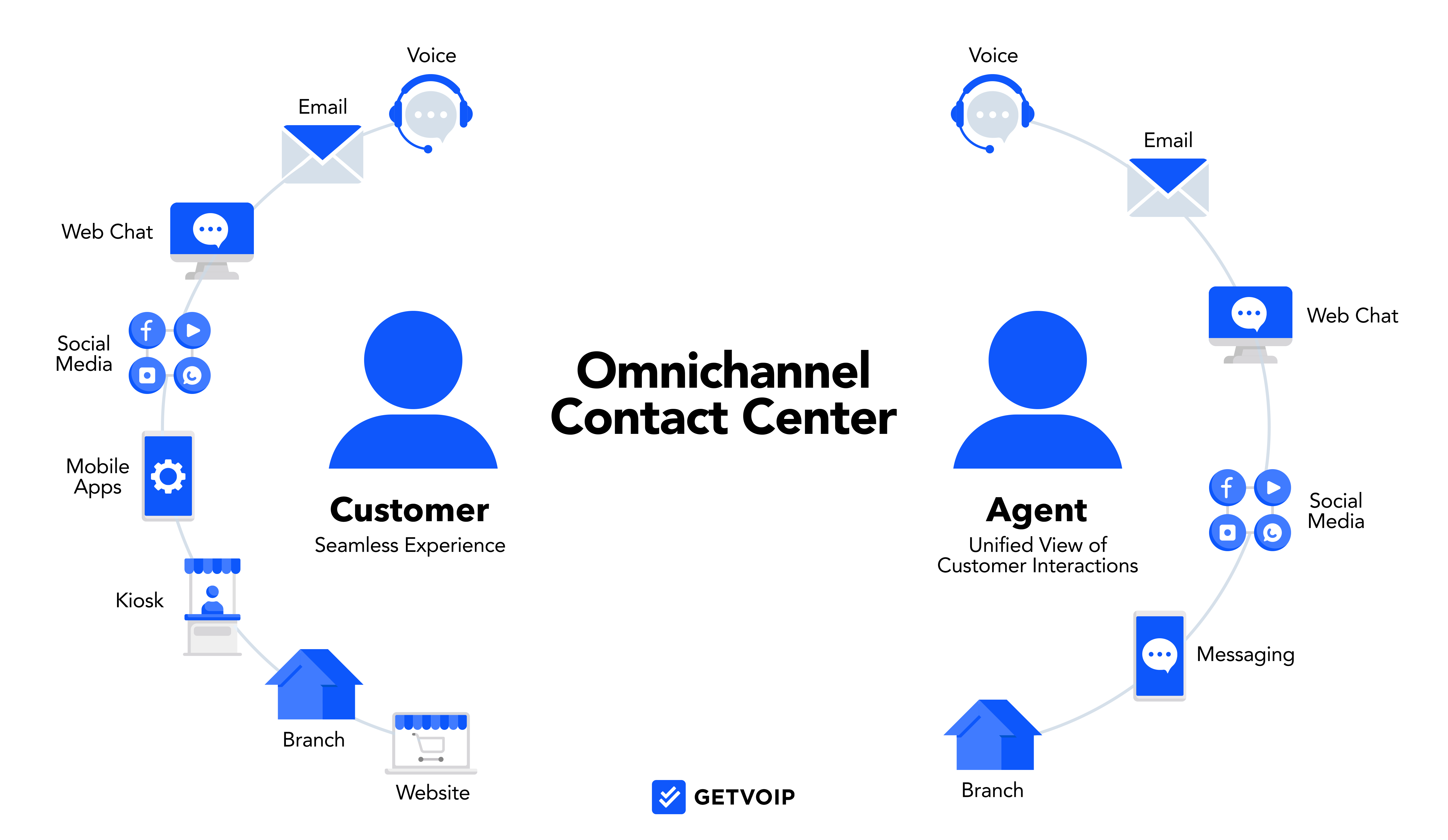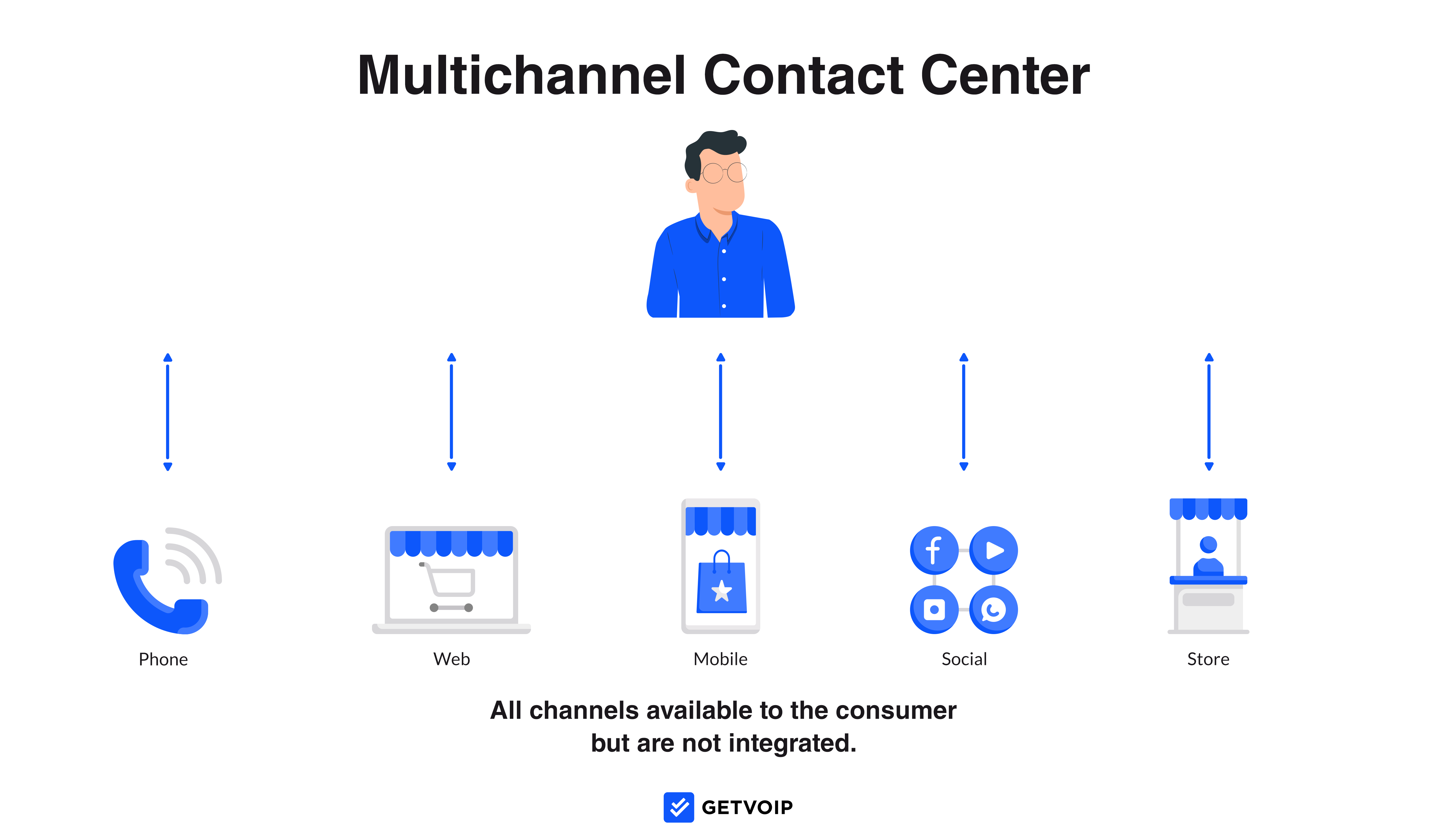Omnichannel and multichannel contact center solutions enable you to serve customers with multiple channels and touchpoints. However, the two types of call center software unify channels differently, leading to distinct agent and customer experiences.
In this article, we’ll compare omnichannel vs multichannel contact center software platforms. Read on to learn about each type’s features, use cases, advantages, and disadvantages.
Key Differences Between Omnichannel and Multichannel Contact Centers
Both omnichannel and multichannel contact centers provide customer service through multiple communication channels like phone, SMS, live chat, and email. However, omnichannel contact centers unify these channels into a singular customer journey, while multichannel contact center software isolates each touchpoint as a distinct interaction.
From an agent’s perspective, omnichannel cloud contact centers offer a single-pane holistic view of the customer’s history, while a multichannel contact center leads to each agent having a more siloed view.
| Omnichannel Contact Center | Multichannel Contact Center | |
| Available channels |
|
|
| Channel unity | Touchpoints unified into a singular, continuous customer journey | Touchpoints isolated into separate tasks and events |
| Cost | $125-$225 monthly per user | $75-$175 monthly per user |
| Agent experience | Convenient, with single-pane view of the customer’s experience and history across channels | Siloed, since agents can only access one touchpoint from the customer’s interaction history |
| Customer experience | Streamlined. Agents have fuller context for each interaction, requiring the customer to repeat less information | Frustrating. Since agents lack full context, customers often need to repeat themselves more |
| Best for | Contact centers with repeat customers or whose customers call multiple times across channels | Call centers that only offer one channel, or teams whose customers typically call only once |
What is an Omnichannel Contact Center?
An omnichannel contact center is a customer engagement solution that unifies multiple communication channels into a single, unified customer journey. Contact center agents can access each communication channel from the software dashboard, with the ability to switch between channels during an interaction.
Omnichannel software logs the customer’s journey in their customer profile, which is accessible to any agent serving the customer. Agents have access to the customer’s data of contact, sentiment scores, channels used, call transcripts, the representatives who previously served the customer, and more.

This single-pane view of the customer’s journey provides each representative with a deep context of the customer’s needs. Since agents can access previous transcripts and actions taken, they can offer a more seamless customer experience. Omnichannel agents can switch between channels during a live call without initiating a new ticket or task. This convenience and improvised customer support are part of why omnichannel solutions are expected to maintain a 13.6% annual growth rate through 2030.
Learn more: Omnichannel Contact Center: Key Features, Benefits, and Best Practices
Standout Features of Omnichannel Contact Centers
Omnichannel contact centers offer several features that set them apart from multichannel contact centers. Look for the following in an omnichannel CCaaS platform:
- Omnichannel dashboard: An omnichannel contact center features a more dynamic and comprehensive user dashboard. Accessible via desktop app, the omnichannel dashboard provides agents a view of all communication channels, tasks, call queues, and rich customer profiles.
- Rich customer profiles: Omnichannel CCaaS solutions provide rich customer profiles, featuring a more intricate view of the customer’s experience. Staff members can view the customer’s full interaction history, the representatives who served them, touchpoints used, sentiment scores, and even purchases made on a database. This information is often extracted from and shared with your CRM system.
- Omnichannel routing: Omnichannel platforms provide skills-based routing automation for all tasks and channels. The software analyzes the customer’s identity, and other information like chatbot and IVR interactions, then forwards the task to the available agent best-suited to help. Omnichannel platforms can also connect customers to agents they previously had, which boosts customer relationships and customer loyalty.
- Conversational chatbots: While multichannel chatbots may offer intelligent virtual agents (IVA), omnichannel platforms offer more conversational IVA systems that use natural language understanding and provide rich service. Omnichannel chatbots identify customers, pull and add information to their profiles, and provide more dynamic services like appointment booking and information retrieval.
- Customizable analytics: Omnichannel analytics track dozens of metrics and trends that traditional multichannel software doesn’t. These real-time analytics include customer sentiment scores, success and resolution rates, and the more frequently discussed topics.
Advantages of Omnichannel Contact Centers
Omnichannel CCaaS software provides several business advantages over a multichannel contact center:
- Better customer service: By unifying each customer interaction into a singular history that any agent can view, omnichannel platforms improve the customer service experience. Providing options for multiple touchpoints, including digital channels, helps you meet customer preferences. This convenience makes a huge difference with the millennial generation, 87% of whom consider convenience a major priority.
- Increased agent productivity: Omnichannel CCaaS software provides agents with more customer context, pulled from your CRM system. Since agents can see customer information like recent purchases and journey history, they can get to the heart of the issue faster.
- Shorter wait times: Omnichannel platforms provide accurate multichannel routing and better live-agent support, which improves first-call resolution and helps agents serve customers faster. This leads to shorter wait times and more customers served.
- Reduced staffing needs: With conversational chatbots and IVA menus with rich capabilities, omnichannel solutions provide strong self-service for customers and reduce call center staffing needs, saving money for your company
- Business insights: An omnichannel platform’s advanced analytics provide unique business insights that help refine your customer-service strategy. The CCaaS platform helps you analyze which agents are providing the best service, which channels your customers prefer, and general customer satisfaction. This data guides more informed business decisions.
Limitations of Omnichannel Contact Centers
Generally, omnichannel customer service offers more features and functionality than multichannel contact centers. Still, an omnichannel strategy has a few drawbacks:
- More expensive: Since omnichannel contact centers include more advanced features and customer-support tools, they generally cost more than multichannel CCaaS solutions
- Steep learning curve: The advanced features, dashboards, and communication channels can take a few weeks to learn–for both agents and supervisors. Analytics dashboards and omnichannel routing can also be frustrating at first, requiring several attempts to customize the way you want.
- Less specialized agents: Some sales and customer-service reps may thrive with a certain channel–such as voice or live chat. An omnichannel platform requires an agent to learn various channels of communication, which may reduce the agent’s opportunities to specialize.
- Unnecessary features: Omnichannel contact centers often bundle hundreds of features–including AI tools, workforce management features, quality management tools, and dozens of analytics options. Many call centers end up using only a fraction of these features, diminishing the platform’s value.
When to Use an Omnichannel Contact Center
An omnichannel contact center supports customer service or sales use cases. Let’s take a closer look at some of the particular use cases and scenarios that can benefit from omnichannel approach:
- Customer service: Use an omnichannel contact center to serve customers across multiple touchpoints–voice, chat, email, and self-service chatbots and IVA. These systems benefit any needs that your customers may have, and the unified journey display helps call center staff stay organized.
- Multi-demographic customer base: Omnichannel platforms work well for companies whose customers are spread across various demographics–ages, income levels, and interests. These customers tend to use different channels and modes of contact, and omnichannel CCaaS enables a consistent experience for them all.
- Companies with repeat customers: Omnichannel CCaaS provides a better customer experience for repeat callers. This is because omnichannel software logs a comprehensive contact and purchase history, helping the call center deepen the customer’s context each time.
- Website and app optimization: Organizations that rely on a website or application as a customer touchpoint can benefit from omnichannel software. Embed a call button or automated chatbot into these touchpoints, providing customers a way to contact you at the strongest interaction point.
- Outbound sales and marketing: Sales-focused call centers will benefit from the deep CRM integrations, outbound dialers, and dynamic customer profiles that an omnichannel platform offers. Sales agents can approach the customer or lead with more context about their preferences, purchases, and interactions with the company.
What is a Multichannel Contact Center?
A multichannel contact center is a customer-service platform that enables communication via multiple channels: voice, SMS, live chat, email, video, and social media. Agents can access these channels for inbound and outbound communication, from the desktop app dashboard. However, each customer interaction generates a new task; multichannel software does not unify each touchpoint or interaction into a singular view of the customer journey.
Compared to omnichannel CCaaS software, multichannel software leads to a more fragmented agent experience. Each time a customer initiates a contact request, the software creates a new task, requiring the agent to start over with no context. If a customer wants to switch channels during a live call, this generates a new task and risks reaching a new agent.

While customers can still reach your company through their preferred channel, agents have a more siloed experience. They can’t see a customer’s previous contact attempts or purchase history, forcing the representative to ask clarification questions that the customer has probably answered in previous interactions.
Learn more: Multichannel Contact Center: Key Features, Benefits & Top Providers
Standout Features of Multichannel Contact Centers
While most multichannel contact center features are also included in omnichannel platforms, look for the following capabilities in a multichannel CCaaS software:
- Multichannel dashboard: The app’s desktop dashboard enables inbound and outbound communication through any of the available channels. However, agents cannot switch channels during a live call, and each inbound query initiates a new task. Customer interactions typically do not display the customer’s journey history.
- Skills-based routing: Multichannel CCaaS platforms analyze a caller’s needs and route them to the best-available agent based on availability and skill. Compared to omnichannel platforms, multichannel routing does not offer the same depth in CRM integrations and analysis of the customer’s history.
- Call queues: Administrators combine agents into departments or hold queues, which organize inbound phone calls in a waiting list if all agents are busy
- IVR menu: Create a self-service routing menu that presents callers with options of departments, users, and announcements. Customers select an option and then either route the destination or reach a submenu.
- Auto dialers: Outbound auto dialers retrieve phone numbers from a database or campaign list, automatically calling numbers down the list one after another. If a recipient answers the phone, the dialer connects the agent. This technology saves agents the time of dialing contacts, waiting for the phone to ring, and leaving a voicemail.
Advantages of Multichannel Contact Centers
A multichannel strategy offers a few advantages over omnichannel platforms. Let’s take a look at the positives of a multichannel approach:
- Easy to learn: Since multichannel platforms have fewer features and a simplified dashboard, they generally have a shorter learning curve than omnichannel CCaaS software
- Lower cost: Multichannel CCaaS platforms generally cost between $75 an $150 monthly per user, which is roughly $75 below what an omnichannel platform may cost
- Agent specialization: With a multichannel contact center, agents can specialize in particular channels. This may lead to more consistent customer service, as agents are more familiar with the controls and features they use most often.
- Easier to monitor: A multichannel contact center generally gives a supervisor less call-center activity and agent performance to monitor. With fewer features and a less comprehensive view of agent performance and customer history, supervisors don’t have to comb through as much information to keep tabs on the call center’s performance.
Limitations of Multichannel Contact Centers
Compared to an omnichannel contact center, multichannel contact centers have a few drawbacks, or limitations:
- Siloed agent experience: Each time an agent handles an inbound query on a multichannel system, they have no picture of the customer’s overall journey. This limited context disables agents from seeing information that would be helpful, like orders and recent interactions.
- Customer frustration: Since multichannel platforms provide customer-service reps with less context than an omnichannel platform, customers have to start from scratch when they reach a new representative. They often must repeat themselves, which wastes time and makes customers frustrated.
- Slower customer service: Compared to an omnichannel platform, multichannel software generally has less sophisticated routing tools and CRM integrations. This may lead to customers reaching the wrong representative on their first attempt, decreasing first call resolution rate and prolonging the required support time.
When to Use a Multichannel Contact Center
- Voice-first call centers: Call centers that only serve customers via voice, with minimal or no digital customer service, do not need omnichannel software. These companies can save money and effort by using a simpler multichannel CCaaS platform.
- Contact centers with fewer agents: Companies with just a handful of service agents may not need omnichannel software, because customers will interact with the same customer-service reps regardless. Advanced omnichannel routing tools and journey tracking are not as necessary in this case.
- Companies just starting a contact center: Those building a contact center for the first time may prefer starting with the simpler and more user-friendly interface that a multichannel contact center offers. New representatives will have an easier time acclimating to the simpler multichannel dashboard.
- Organizations with a small budget: Support teams on a budget will save money by choosing multichannel software since multichannel platforms generally have lower pricing than omnichannel
Which Should You Choose?
Omnichannel and multichannel contact centers each have advantages and use cases. Omnichannel software works well for large contact centers with many agents, or companies that want to unify multiple customer-facing touchpoints into a singular customer journey. Multichannel contact centers don’t provide the same channel unification, but they offer a cost-effective alternative that works well for small contact centers, or call centers focused primarily on voice.



